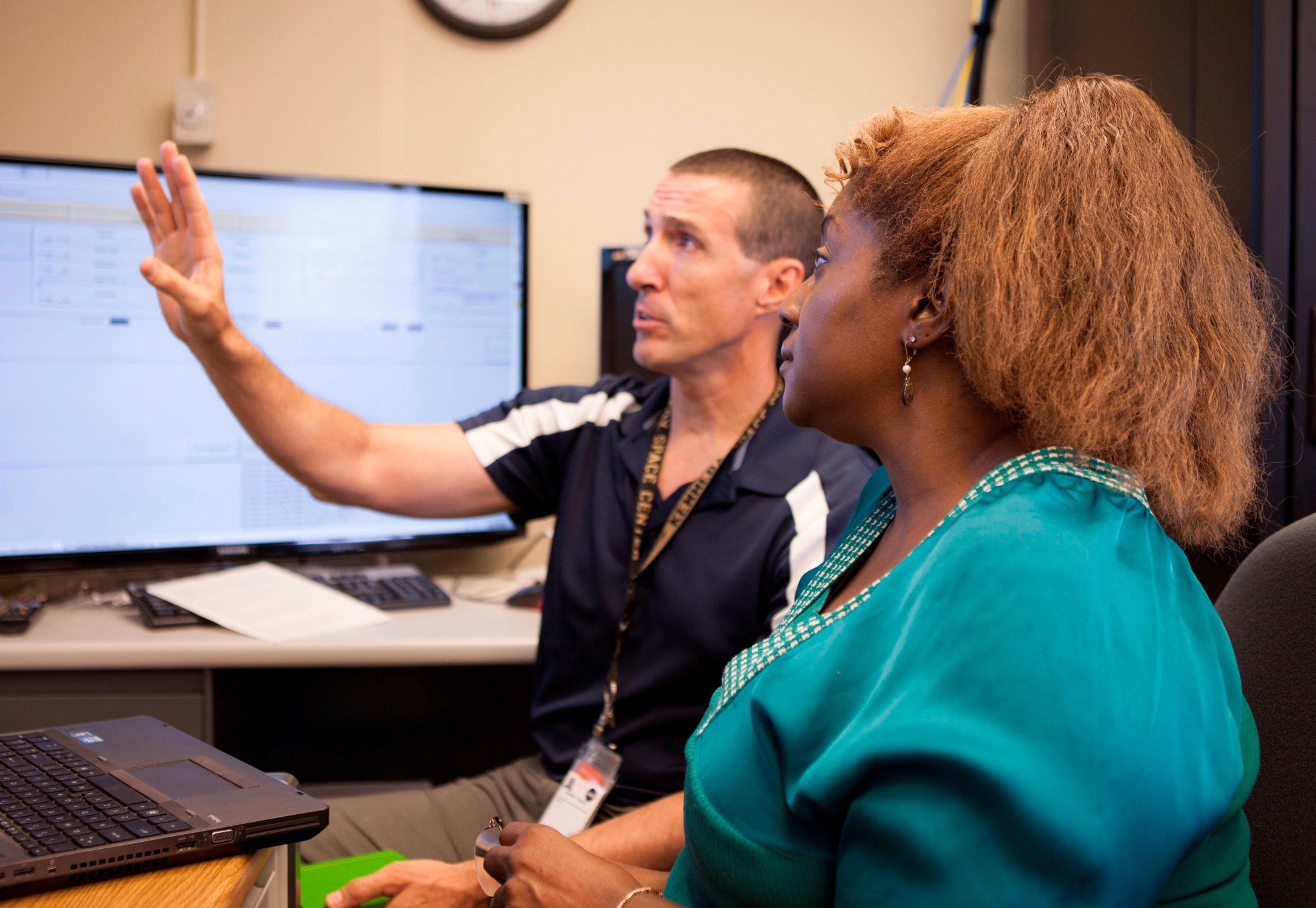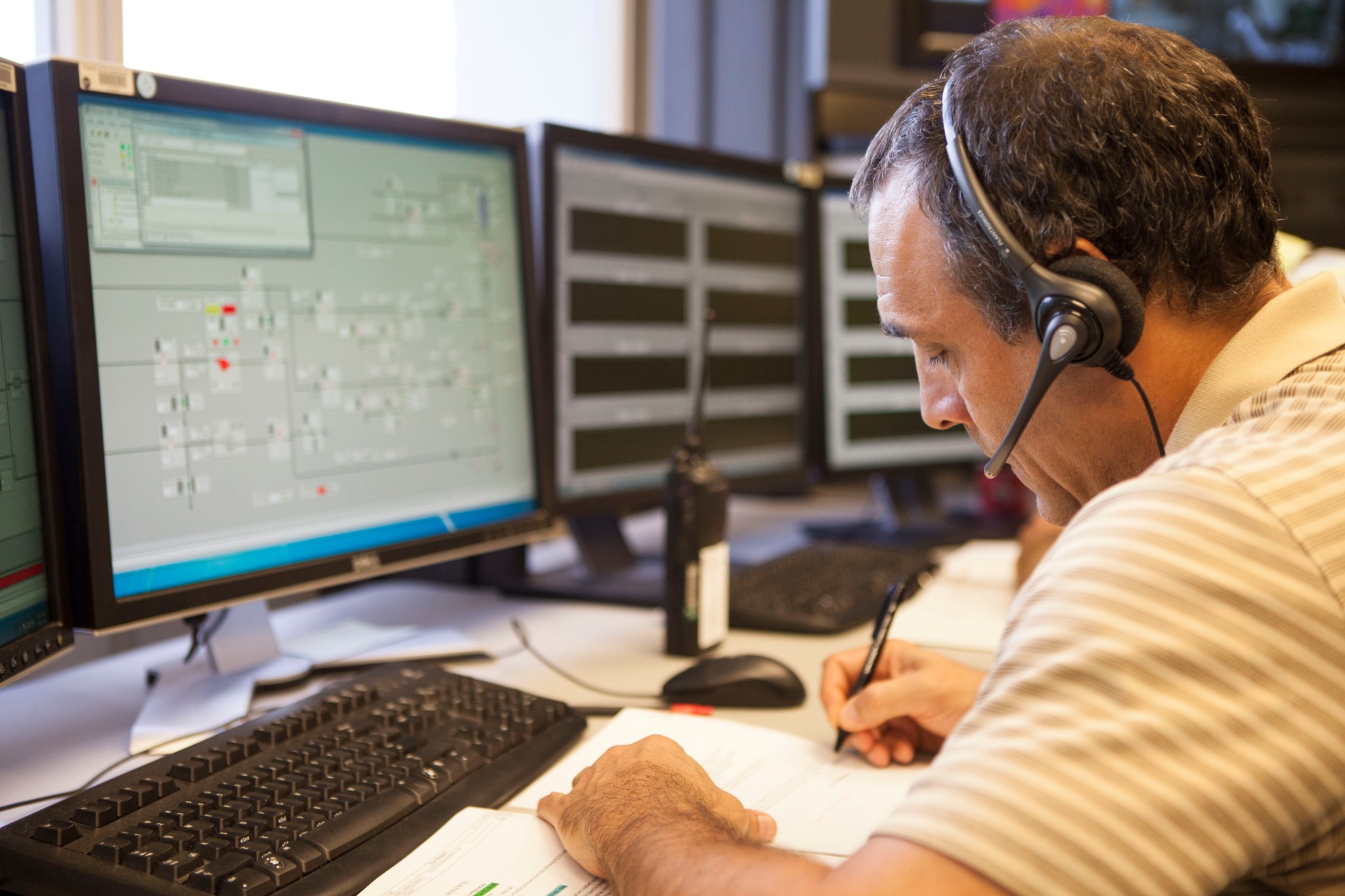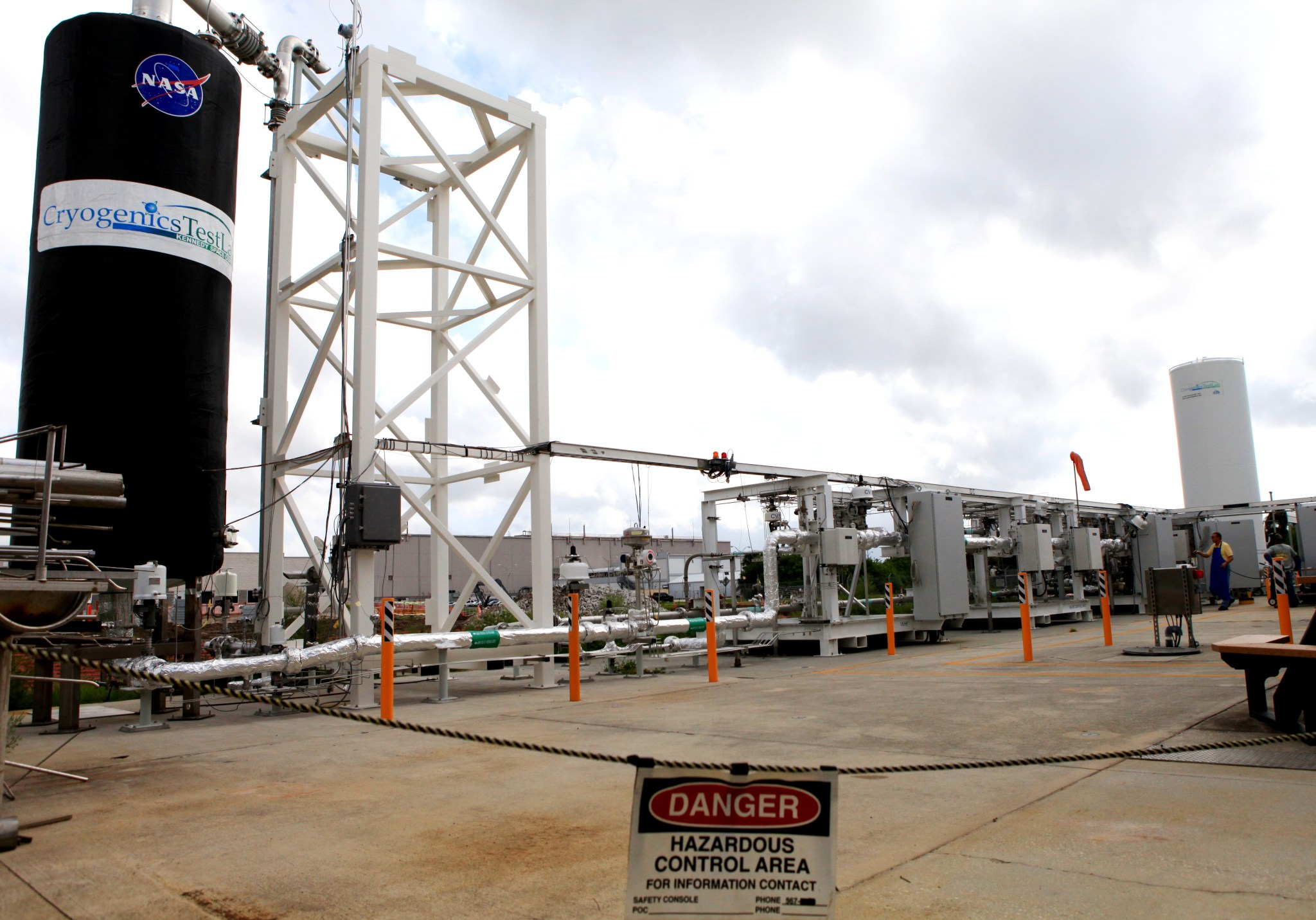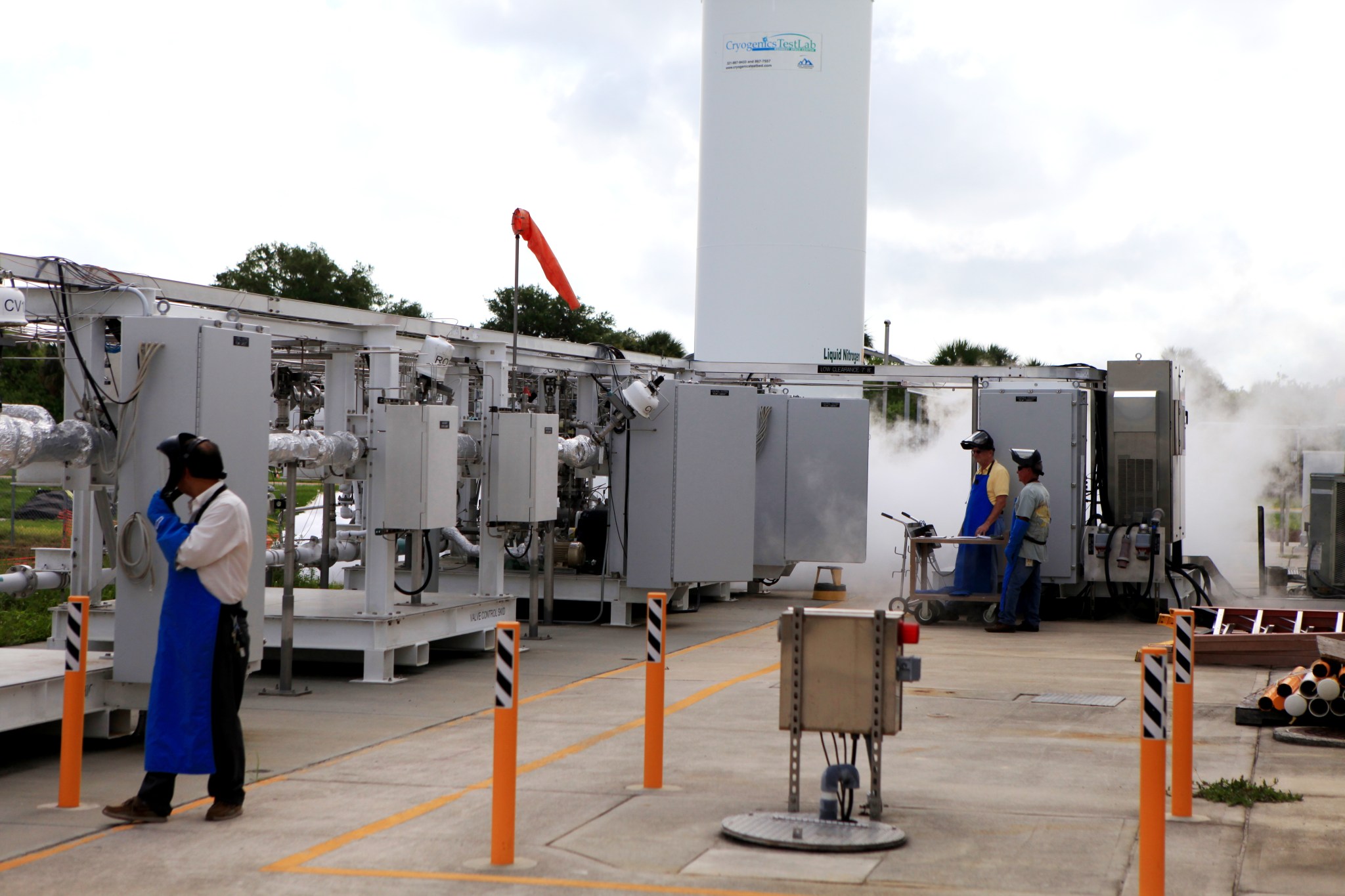Imagine it’s 2018. A rocket stands ready for a flight on a deep-space mission. Shortly after loading of liquid oxygen propellant begins, engineers monitoring the process receive an indication of a valve stuck in an open position when it should be closed. An autonomous system checks the valve’s sensors, determining that it is, in fact, closed. Assurance that it was only an instrumentation problem averted a costly postponement.
Designed to do just that and much more is the Autonomous Cryogenic Loading Operations (ACLO) Project’s Knowledge-based Autonomous Test Engineer, or KATE. It recently was assessed by engineers at NASA’s Kennedy Space Center in Florida who hope soon to implement the innovation.
The operation took place at the spaceport’s Cryogenics Test Laboratory using the Integrated Ground Operations Development Unit (IGODU). This test bed serves as a facility for developing and checking out cryogenic technologies and concepts for future ground propellant loading and servicing operations.
While cryogenic propellants have been used throughout the history of the space program, they involve many challenges. The super-cold elements have temperatures of less than 238 degrees below zero Fahrenheit. The space shuttle’s main engines used liquid oxygen and liquid hydrogen that were pumped from the launch pads’ ground storage units into the external fuel tank.
“During the Space Shuttle Program, it took many people to operate and maintain the cryogenic loading system,” said Barbara Brown, a project manager in NASA’s Engineering and Technology Directorate, who is the principal investigator for the ACLO Project. “We’re hoping to implement an automated and autonomous inspection system that will help us quickly isolate and resolve problems that may come up in the future.”
Although funded from different sources, the ACLO and IGODU projects are complementary. They have the common goal of maturing an autonomous control capability and validating the concepts using cryogenic loading systems that monitor a propellant loading system’s health and performance. The ACLO Project also is designed to aid in developing autonomous control capability for control of crucial, complex systems with less human oversight.
ACLO is a project of the Space Technology Mission Directorate (STMD) under NASA’s Game Changing Development (GCD) Program. STMD is responsible for developing new tools and capabilities needed by NASA to achieve its current and future mission goals. STMD does that by rapidly developing and demonstrating revolutionary, high-payoff technologies through collaborative partnerships. The result of these investments enables NASA to support a broad array of future missions and make a difference in the world around us with spin-off innovations.
IGODU is part of the agency’s Advanced Exploration Systems (AES) program. AES is pioneering new approaches for rapidly developing prototype systems, demonstrating key capabilities and validating operational concepts for future human missions beyond Earth orbit.
Brown noted that the recent demonstration of ACLO met the first milestone under the GCD Program. Additionally, the Ground Systems Development and Operations Program at Kennedy now has agreed to evaluate the capability.
“ACLO and IGODU are sharing in the development of the autonomous control capability for propellant loading, leveraging resources and integrating components to help develop these new technologies,” she said.
Cryogenic propellant loading operations for the shuttle typically involved several large groups of highly-specialized engineers and managers monitoring the propellant ground and flight systems during the crucial final hours prior to launch. The hazardous nature, complexity and vulnerability of the launch vehicle, as well as associated ground servicing systems, combined to drive the size of this workforce on launch day. The experts made decisions about the ability to continue safe operations, recover from system faults or failures, and whether to postpone the operation.

“Our goal is to reduce the number of people required to control crucial, complex systems,” Brown said. “In addition, we need to ensure new capabilities safely and efficiently load propellants on future launch vehicles such as the Space Launch System.”
A powerful new launch vehicle, the Space Launch System, or SLS, will take astronauts farther into space than ever before using NASA’s Orion spacecraft, providing a new capability for human exploration beyond low-Earth orbit.
The autonomous cryogenic loading capability and component technologies developed under the ACLO Project also will be used to help improve concepts for variable levels of self-sufficiency. This will help NASA rapidly adapt to and support various launch concepts with different types of rockets at a single launch pad.
During the recent assessment, engineers and scientists at Kennedy’s Cryogenic Test Laboratory preformed a test of the ACLO’s autonomous control software using KATE. The operation was designed to simulate loading cryogenic propellants into a rocket prior to launch and find any technology gaps in the software.
Robert Johnson, of the Research and Technology Management Office in Kennedy’s Center Planning and Development Directorate, manages the IGODU project and is working with Brown in managing the joint projects. He noted that the IGODU test bed is set up just outside the Cryogenic Test Lab’s control room. Two large cylindrical storage tanks are connected by a series of highly instrumented pipes. The setup was designed to simulate a ground storage vessel from which to load cryogenic propellant into a rocket fuel tank.
“It consists of a small scale propellant loading system that mimics the cryogenic propellant servicing system at a typical launch pad,” he said. “It includes a 6,000-gallon propellant storage tank, a pumping complex, control valve skids and a 2,000-gallon container simulating a rocket propellant tank.”
The Simulated Propellant Loading System (SPLS) at the Cryogenic Test Bed Laboratory provides an environment for testing advanced cryogenic components, sensors and health management technologies.
Johnson explained that it also allows demonstration of a control system capable of recognizing and automatically correcting simple system failures typical of launch vehicle servicing systems. The connecting pipelines include valves and sensors similar to what would be used at a launch pad.
“For this test we used liquid nitrogen,” he said. “We had a series of valves and over 150 sensors along the pipes, to provide data on temperature, pressure and flow rates.”

Autonomous controls can independently attempt to overcome instrumentation failures by bypassing failed sensors and components or redefining control points. The automation of functions and processes within the system is designed to provide repeatable, reliable loading operations that need only minimal human oversight and intervention.
During the recent test, the team followed the operation on a series of computer monitors displaying data provided by the sensors. As hardware failures occurred during the SPLS operation, the KATE system determined if a failure indication was actually a hardware fault or an instrumentation failure and issued advisory recommendations to those monitoring the test to continue the operation.
“This was during the interactive control mode,” Brown said. “During autonomous control mode, KATE actually performed the diagnosis and autonomously issued the recovery steps.”
Charlie Goodrich, an engineer with Technik Inc. who was supporting the cryogenic loading test, noted that a launch day scrub can cost millions of dollars.
“A system that helps us determine that it’s just instrumentation and not a real fault would make us more efficient and be more cost-effective,” he said.
Technik provides management systems engineering services, software development, project management and other support functions for the agency’s Information Technology and Communications Services Directorate at Kennedy.
Brown began working on the concept for Autonomous Cryogenic Loading Operations in 1988.
“We developed and tested it for the Space Shuttle Program using the liquid oxygen system, but it was never deployed as one of the Firing Room monitoring applications,” she said. “As we’re now working to transition to an affordable, multi-user spaceport, we need to refocus on cost-effective ways of doing business.”
Brown explained that when the KATE system is implemented, it could provide health and status only or it could autonomously control the cryogenic propellant loading operations under nominal and off-nominal conditions. In either situation, it would identify anomalies, isolate component failures and safely continue operations in degraded conditions or recover system function.

“We hope to provide repeatable, reliable autonomous loading operations and reduce the heavy reliance on a large group of people being available to operate and maintain ground systems and to conduct launch operations,” she said. “Ultimately, we want to reduce the workload on human operators and lower the cost of operations and maintenance.”
The next portion of the project being considered for development is a robotic unit capable of inspections and repairs.
“The mobile platform, or Advanced Inspection System (AIS), would provide an automated inspection and repair capability,” Brown said. “Complete with a camera, sensors and tools, the unit could venture into areas that would be too hazardous for humans.”
The mobile inspection capability could assist operators during propellant loading. Looking like a toolbox on wheels, the device will have a television camera and mechanical arm for conducting repair tasks. Both KATE software and AIS will be further demonstrated during the execution of the Advanced Propellant Loading System Project managed by Johnson.
In the future, Brown believes the technologies will provide viable options for executing a countdown for future launch vehicles.
“We’re pleased with the progress so far,” Brown said. “Hopefully, this will help NASA achieve its cost goals as we explore beyond Earth.





























